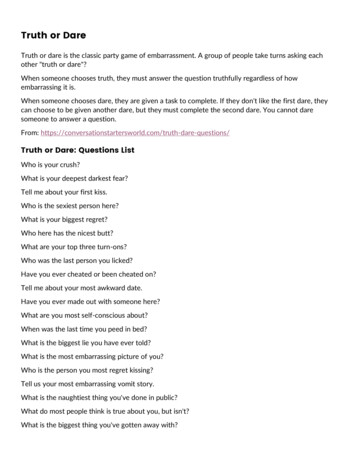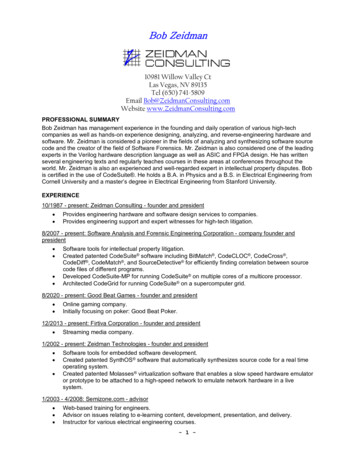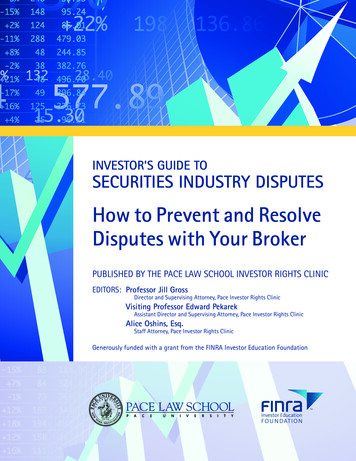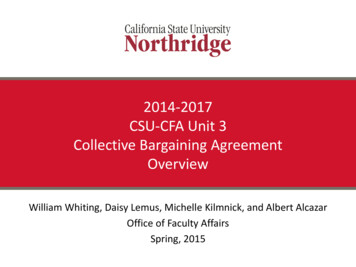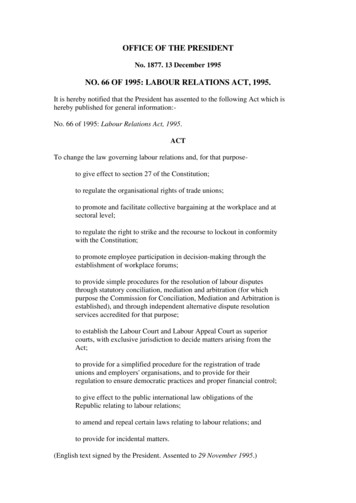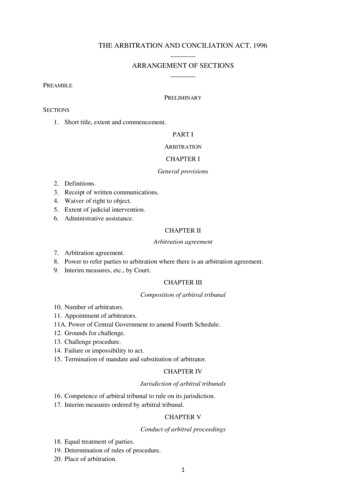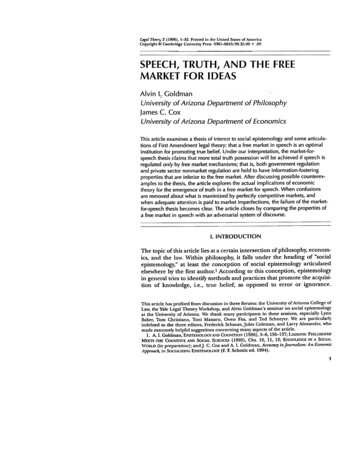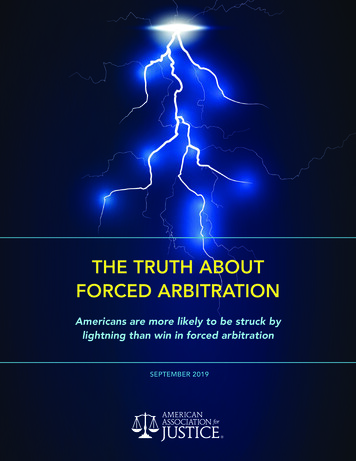
Transcription
THE TRUTH ABOUTFORCED ARBITRATIONAmericans are more likely to be struck bylightning than win in forced arbitrationSEPTEMBER 2019
About the American Association for Justice (AAJ)The American Association for Justice works to preserve the constitutional right to trial by juryand to make sure people have a fair chance to receive justice through the legal system when theyare injured by the negligence or misconduct of others—even when it means taking on the mostpowerful corporations.777 6th Street, NW, Suite 200Washington, D.C. 20001www.justice.orgCopyright 2019 American Association for Justice . Reproduction of any kind is prohibited. Formore information, please contact AAJ Research at research@justice.org or at (800) 424-2725 or (202)965-3500, ext. 2811.
THE TRUTH ABOUTFORCED ARBITRATIONSEPTEMBER 2019
TABLE OF CONTENTSExecutive Summary .6Introduction: How Forced Arbitration Eliminates Claims .8Fairer? Who Wins in Forced Arbitration? .13Faster? Time to Resolution .20Better? Repeat Players in Forced Arbitration? .22Nursing Homes, Employment, and Financial Services .26Conclusion .31Methodology .32Endnotes .34
EXECUTIVE SUMMARYForced arbitration is a rigged system designed by corporations in which injured workers and consumers have no meaningfulchance of finding justice. Forced arbitration requires Americans to “agree” to surrender fundamental constitutional rights – oftenwithout ever realizing they’ve done so. When corporations harm workers and consumers by cheating, stealing, or even breakingthe law, cases that should be heard by a judge or jury are instead funneled into a secret system controlled by the wrongdoersin which there is no right to go to court, no right to a jury, no right to a written record, no right to discovery, no transparency,no legal precedents to follow, no opportunity for group actions when it would be too difficult or costly to file a claim alone, noguarantee of an adjudicator with legal expertise, and no meaningful judicial review. Without such checks and balances, the deckis stacked heavily against workers, patients, and consumers, and systemic misconduct is allowed to continue in secret.Forced arbitration’s proponents counter that the process is faster, fairer, and better for workers and consumers than going tocourt. However, this comprehensive analysis of the self-reported data provided by the arbitration organizations makes clear thatforced arbitration is not an alternative judicial process, but instead eliminates claims, immunizes corporations, and allows abuse,discrimination, fraud, and essentially all other corporate wrongdoing to go unchecked. Americans are more likely to be struck bylightning than they are to win a monetary award in forced arbitration.Claim Elimination It is estimated that more than 800 million arbitration provisions permeate our everyday lives.1 However, the AmericanArbitration Association (AAA) and JAMS, the two most dominant consumer arbitration providers, recorded onlyapproximately 30,000 consumer arbitrations over five years (2014-2018), an average of just 6,000 per year. In contrast, there are more than 2 million small claims cases filed in court every year.2 Despite having millions of customers—all subject to forced arbitration agreements—corporations such asAmazon (101 million Prime subscribers but just 15 forced arbitrations over five years), GM (8 million vehicles solda year but just 5 forced arbitrations over five years), and Walmart (275 million customers a week but just 2 forcedarbitrations over five years) rarely face any claims.Consumer Winners Only 1,909 consumers won a monetary award over the five-year period. On average, approximately 382 consumers won a monetary award each year—less than the number of people struck bylightning each year in the United States.3 Only 6.3% of cases arbitrated at either AAA or JAMS resulted in consumers winning a monetary award over the five years. Over the last five years, no corporation has used forced arbitration more than AT&T. Nearly 1,000 consumersattempted to go through the forced arbitration process between 2014 and 2018, claiming more than 440The Truth About Forced Arbitration6
million in damages. Seventeen consumers won a monetary award, collecting a total of just 376,251.Nursing Home Forced Arbitration Forced arbitration clauses allow nursing homes to avoid accountability for everything from negligent care to sexual assault. Over five years, consumers pursuing a nursing home claim with wither AAA or JAMS won a monetary award in only fourcases. In one case, the corporation—The Rehabilitation & Nursing Center at Greater Pittsburgh—was awarded 20,000more than it had claimed. The arbitrator in that case was a former human resource counsel to a large hospitalsystem in Ohio.Employment Forced Arbitration Of the 60 million employees subject to forced arbitration, only 11,114—0.02%—tried to pursue a dispute in forcedarbitration. Just 282 of these employees were awarded monetary damages over the five-year period, an average of 56 workers peryear—less than one-ten-thousandth of one percent of covered workers. The corporation with the most employment arbitration cases at AAA was Darden Restaurants, owners of theOlive Garden and LongHorn Steakhouse chains. Since 2005, Darden has paid over 14 million to settle lawsuitsfiled in court over reprehensible working conditions. However, in forced arbitration, Darden faced just 329 claims.Employees won an award in just eight cases, for a total of 73,961.Forced Arbitration Involving Credit Cards and Banks Consumers pursued 6,012 forced arbitrations involving financial claims, claiming at least 3.7 billion in damages. They wonmonetary awards in just 131 cases (2.2%), totaling 7.4 million—0.2% of the claimed damages. Corporations pursued 137 financial claims through arbitration, but remarkably won monetary awards in twice as many asthey initiated, winning 5.4 million in 314 cases. No bank used forced arbitration more than Spain-based Santander. Consumers initiated 848 arbitrations against thecorporation, claiming 44 million in damages. Only three consumers won a monetary award, for a total of 10,978,equivalent to 0.000002% (two one-hundred-thousandths of one percent) of the corporation’s 315 billion in revenues.Data Manipulation AAA, the country’s largest consumer arbitration provider, deletes data every quarter in a way that significantly distortsarbitration results. AAA deletes cases by filed date, instead of closed date, even though this is a database of closed claims. This has the effect ofsystematically scrubbing claims that take a long time from its database. The longer a case takes, the quicker it is purged from the database. All research claiming that arbitration is faster thanlitigation has been skewed by this data elimination. The oldest known filed case was filed in August of 2009—a business-initiated residential construction case—andwas closed four and half years later in March 2014. However, because the case was pending it did not appear inany published database until the second quarter of 2014, and then was deleted in the very next quarter because ofits early filing date.7The Truth about Forced Arbitration
INTRODUCTION:HOW FORCED ARBITRATIONELIMINATES CLAIMSForced arbitration clauses are endemic in today’s marketplace—hiddenin everything from credit card agreements to pest control contracts. It isestimated that more than 800 million arbitration provisions infiltrate oureveryday lives.4 Given how common such forced arbitration clauses are, itis surprising how few cases are ever pursued through arbitration. AAA andJAMS are the predominant arbitration organizations for consumers forcedinto arbitration.5 Yet over the last five years, the two organizations haverecorded only approximately 30,000 consumer arbitrations, an average of6,000 per year.6To put that number in context, there are more than 2 million claims in smallclaims court each year.7As this report shows, there is a clear reason for the disparity between thenumber of forced arbitration clauses in effect and the number of cases thatare ever filed by consumers. Forced arbitration is a rigged corporate-friendlyscheme in which consumers have the odds stacked against them.Although some states have passed laws requiring arbitration organizationsto disclose information to the public about consumer arbitrations, thisinformation is limited, error-filled, and subject to manipulation by theissuing organizations.8 Nor is there any access to the underlying materials,meaning that individual case information detailing systematic negligence andwrongdoing remain concealed from the public eye. These limited, incompletedisclosures pale in comparison to the information available in traditionalcourt cases.It is difficult to quantify how many consumer arbitrations there are becauseof the way the arbitration providers count cases. Neither AAA nor JAMSpublish cases in their databases until the cases are concluded (other arbitrationorganizations include “pending” cases), so information on the number ofcases filed is incomplete.In addition, AAA deletes data every quarter. In fact, not only does AAA deletedata but it deletes data by “filing date,” which has the effect of removingclosed cases from subsequent years. In effect, AAA is not deleting casesbased on how old they are but on how long they took.The Truth About Forced Arbitration8
Because AAA deletes cases by filed date instead of closed date, claims thattake a long time are automatically scrubbed from its database. For instance,archived records preserved by Yale Law School show that more than 1,000closed cases in 2014 have been deleted from AAA’s current records for 2014.9At least 389 of those cases took more than a year, 90 took more than twoyears, and 20 took more than three years—all of which have been purged.The oldest known filed case was filed in August of 2009 and was closed four-and-a-half years later in March 2014, but it was deleted from the databasethat same year (the third quarter of 2014). In reality many more cases closedin 2014 are likely to be missing and any cases that took longer than four yearswill have been deleted.This data manipulation—whether done purposefully or by accident—has majorramifications for researchers and policymakers trying to judge the efficiencyand fairness of forced arbitration.This analysis of AAA and JAMS closed claims examines cases that were filedand terminated during the five years from 2014 to 2018. We attempted tocompensate for AAA’s data deletion by restoring missing data culled fromarchived databases. To pinpoint consumer success, we focused on the onlytrue measure of a documented consumer victory: monetary awards. Thenumber of successful consumers identified this way was actually higherthan the given number of “prevailing” consumers and appears to be a moreaccurate measure of how many consumers are truly successful.How Many Consumer Forced Arbitrations AreThere?Over the last five years, the two major arbitration providers have only recordedaround 30,000 consumer arbitrations, an average of 6,000 per year. To putthat number in context, AAA’s total alternative dispute resolution (ADR)caseload, including commercial arbitration, is approximately 200,000 caseseach year.10YEARCASES 99,16530,339Total consumer arbitrations at AAA and JAMS - 2014-2018.9The Truth about Forced Arbitration
Case TypesForced arbitration provisions are most frequently associated with financialservices agreements, like credit cards, or employment contracts. But they arealso found in a wide variety of other situations, including everything fromdating apps to nursing home contracts.AAA’s cases are split into five broad categories.11The “Consumer” cases are then split into further subsets.JAMS does not use the same categories, though there is some overlap.The Truth About Forced Arbitration10
Why Don’t Consumers File in ForcedArbitration?As mentioned above, over the last five years, the two major forced arbitrationproviders have recorded only approximately 30,000 consumer arbitrations.This is not an indication that forced arbitration does not work but rather thatit works just as intended: by eliminating claims. As University of WisconsinMadison Law professor David S. Schwartz puts it:“It is not a justice system It is not demonstrably fair. It is not imposed to promotesmall claims or otherwise help the “little guy” who is excluded from meaningful accessto the courts. Finally, let’s stop calling it “mandatory arbitration,” that bloodless,hypertechnical, and misleading term. “Mandatory” implies that the arbitration processis binding on both sides, but that is less than half true: it is voluntarily chosen by thedefendant, who drafts the arbitration clause, and “mandatory” only on the party whodoesn’t want it, typically the plaintiff. So what is this thing? It is claim-suppressingarbitration. It is designed and intended to suppress claims, both in size and number.”12Other researchers have come to the same conclusion.13 A 2015 New YorkTimes investigation backed up these conclusions, finding that some ofthe country’s largest corporations, with millions of customers subject topervasive forced arbitration clauses, only ever faced a handful of consumerarbitrations. “Corporations said that class actions were not needed because arbitrationenabled individuals to resolve their grievances easily,” the Times wrote. “But court andarbitration records show the opposite has happened: Once blocked from going to court as agroup, most people dropped their claims entirely.”14“Once blocked from going to court as a group,most people dropped their claims entirely.”– The New York TimesThe Times investigation found that between 2010 and 2014, “only 505 consumerswent to arbitration over a dispute of 2,500 or less. Verizon, which has more than 125million subscribers, faced 65 consumer arbitrations in those five years, the data shows.Time Warner Cable, which has 15 million customers, faced seven.”Consumers Do Not Understand Forced ArbitrationThe Consumer Financial Protection Bureau (CFPB) studied forced arbitrationextensively, and concluded few consumers chose to try their chances in forcedarbitration. According to the CFPB, “almost no consumers filed arbitrations aboutdisputes under 1,000.”15 The agency also noted that out of 13 million consumersin conventional class actions, only 3,605 opted out of the settlements, andonly a handful of those chose to file an arbitration claim.1611The Truth about Forced Arbitration
One reason the CFPB suggested that consumers did not pursue arbitrationclaims was that the arbitration agreements were too impenetrable for them tounderstand. A 2015 survey conducted by St. John’s University Law ProfessorJeff Sovern found definitive evidence of such confusion and concludedconsumers had a “profound lack of understanding about the existence and effectof arbitration agreements.”17 The survey found that while 43% of consumersrecognized a sample contract included an arbitration clause, 61% believedthey would, nevertheless, have a right to go to court. Less than nine % realizedthe truth: that there was a clause that would prevent them from exercisingtheir constitutional right to go to court. Writing in American Banker, Sovernconcluded, “the consent consumers provide when they sign a contract taking away theirright to sue is no more meaningful to most consumers than if the clause had been printedin a foreign language.”18“The consent consumers provide when they signa contract taking away their right to sue is nomore meaningful to most consumers than if theclause had been printed in a foreign language.”– St. John’s University Law Professor Jeff SovernAlan Kaplinsky, one of forced arbitration’s leading proponents, has alsoacknowledged that there are few consumer arbitrations. Kaplinsky claimsthat’s because instead they either call the company to complain or go to theBetter Business Bureau: “That’s why you don’t see a heck of a lot of arbitration orlitigation when there’s a clause.”19 There are no data to back this up though, andlong-standing research suggests consumers don’t complain to the companyor Better Business Bureau.20CompanyNumber of Customers (U.S.)Number of Arbitration Casesfrom 2014-2018 (AAA & JAMS)AmazonAT&T (includes DirecTV)CVSFedExGMKrogerUnited Health GroupWalmart101 million Prime subscribers177 million AT&T subscribers5 million customers per day15 million shipments per day8.38 million vehicles sold in 20188.5 million customers per day142 million individuals served275 million customers per week15940468522392Despite having millions of customers and employing forced arbitration agreements, corporations face a comparatively small number of claims.The Truth About Forced Arbitration12
FAIRER? WHO WINS IN FORCEDARBITRATION? 1,909 – Number of Consumer Winners at AAA/JAMS over five years 382 – Average Number of Consumer Winners at AAA/JAMS per year 6.3% – Percentage of Consumer Winners at AAA/JAMS averaged overfive yearsPerhaps the most compelling theory for why consumers do not pursueforced arbitration claims against corporations is that they may suspect thata dispute resolution process suggested by the corporation (in fact, requiredby the corporation) is unlikely to offer them much chance of success. In this,consumers are correct.The 2015 CFPB analysis of arbitrations in six consumer financial marketsfound that consumers were successful just 20% of the time.21 However,analysis of AAA and JAMS’ databases shows consumers are far less successfulacross all industries.As the CFPB has pointed out, it is not easy to figure out who wins in forcedarbitration or even what should count as a win.22 Both AAA and JAMS list“prevailing” parties, but many cases finished in ways that were inconsistentwith the given “prevailing” party. In hundreds of cases at AAA, one partywould be listed as prevailing when the other received a monetary award. In onecase, a consumer was listed as prevailing but a note mentioned he or she wasordered to return a car. In another case, an employee was listed as prevailingand winning a 390,000 award, only for the corporation to receive 59 million.23Conversely, many of those consumers who did win a monetary award arenot listed as prevailing. Similarly, JAMS listed 306 prevailing consumers, butonly 227 featured an award, monetary or otherwise. Seven of the “prevailingconsumer” cases were, in fact, abandoned, withdrawn, or dismissed.24 “Both”parties were listed as winners in 11 cases. JAMS also often listed “both” partiesas prevailing but then did not specify which party received the award, makingit impossible to know if a consumer was truly successful.Both organizations also list “awarded” as an outcome, but hundreds of these“awarded” cases feature no monetary or non-monetary award.13The Truth about Forced Arbitration
Yale Law School Professor Judith Resnik highlighted the challenges offiguring out case winners when trying to investigate AT&T’s arbitration cases:“In the 316 cases in which AT&T was involved between 2014-2017, thirty-ninewere described as ending in decisions, called “awards,” 251 settled, and twenty-six fellunder the categories of “administrative,” “dismissed,” or “withdrawn.” Within thethirty-nine “awarded” cases, twenty-two involved instances when AT&T “prevailed.”Of those cases, in three, consumers were to pay the company in amounts rangingfrom 566 to 2103. In the other seventeen cases that ended in awards, the AAAcompilation listed “zero” as funds that would be ordered paid; in nine instances, thecompilation listed no party prevailing. In one case, no party was listed as prevailing,but the consumer was described as receiving a positive award. Counting this case alongwith the other seven claims in which consumers were listed as prevailing, these eightconsumer awards ranged from 2.23 to 1,449, with a median of 525.36.” 25Non-Monetary AwardsBoth AAA and JAMS include limited data on non-monetary relief but againthe data here are misleading in terms of indicating wins and losses. At AAA,2,249 consumers were listed as receiving non-monetary relief. However, inmore than 100 of these cases, corporations were said to have prevailed andin 36 of these cases, corporations won monetary awards, rendering theminconsistent with a successful consumer outcome. In 1,356 of these cases,the non-monetary relief was listed as “other.” The relief in the rest of thecases was either recission/reinstatement (as in the reinstatement of a loan),or declaratory judgments (the details of which remain unclear).JAMS offered more concrete details about non-monetary awards in 30 cases inwhich consumers allegedly prevailed. In seven cases, the consumers’ “award”turned out to be a complete denial of claims and explicit recognition of thecorporation as the winning party. In five cases, the “award” was a dismissal,including two which explicitly denied “class-wide arbitration.” In eight cases,there was some recognizable consumer relief, including continued phoneservice, deletion of an item from a credit score, reinstatement and back pay,and repair of an air bag.Monetary AwardsGiven the inadequacies of the data on “prevailing” parties and non-monetaryawards, this analysis focuses on the only true measure of a documentedconsumer victory: monetary awards. This study sought to identify consumerswho won a monetary award greater than the corresponding business award(in many cases consumers won an award but the opposing corporation wonthe same or an even higher award). The number of successful consumersdefined this way was actually higher than the given number of “prevailing”consumers, but appears to be a more accurate measure of consumer success.The Truth About Forced Arbitration14
JAMS offered its own unique challenge by listing “both” parties as prevailingbut not distinguishing which party won the listed award (to be conservative,this analysis considered these consumer wins).AAAConsumer v. Any Corporation1,686 (7.1%)Number of Consumer WinnersJAMSAAA JAMSCombined223 (3.3%)1,909 (6.3%)On average, approximately 382 consumers win a monetary award in arbitrationeach year. More people are struck by lightning each year in the UnitedStates.26Consumer Winners by Case TypeOverall, in consumer cases, consumers won monetary awards in 5.5% ofcases (employment cases saw employee monetary awards even less frequentlyat 2.3%). But the type of dispute made a significant difference to consumersuccess. The highest rate of consumers winning a monetary award was in pestcontrol cases (22.8%). On the other hand, no consumer received a monetaryaward in any nursing home case over the entire five years.AAA—Consumers Winning Monetary Awards by Case TypePest ControlHealth Care (Patient/Provider)Consumer & Residential ConstructionCar Warranty/MaintenanceConsumer Real EstateCar Sales/LeaseEducationTravel InsuranceInsurance (Other)Hospitality/TravelWarranties (Non-Car)AccountingTelecommunications (Phone, Cable)ALL CONSUMER CASESLegal ServicesDebt CollectionEmploymentFinancial ServicesHealth %10%7.4%7.2%6.6%5.8%5.5%4.7%3.6%2.3%2.1%zero %The Truth about Forced Arbitration
Standardized TestingNursing Homezero %zero %JAMS—Consumers Winning Monetary Awards by Case TypeInsuranceGoodsTelecommunications (phone, cable)OtherBusiness/Commercial (still involving consumers)Health CareEmployment20%7%4.8%4%3.8%3.4%3.1%CreditOther Banking or FinanceProfessional Liability/MalpracticePersonal InjuryDebt CollectionConstructionReal Estate2.8%2.3%2.3%1.7%0.9%zero %zero %When Corporations File Against ConsumersWhen businesses initiated a case against a consumer, they won a monetaryaward 24.8% of the time. When consumers initiated a case, they wonan award 7.4% of the time. Beyond that were several curious findings.Consumers actually did better when a corporation initiated a case than whenthey themselves initiated a case, “prevailing” more often (5% of the timein corporate-initiated cases versus 4.6% of the time in their own cases) andwinning monetary awards more often (9.1% of the time in corporate-initiatedcases versus 7.4% of the time in their own cases).No company initiated more cases than ACT, Inc.—the companythat administers the ACT test for high school students. ACTinitiated 208 cases, all but two of which ended as “awarded” (onewas settled and another withdrawn). However, none featured anymonetary award and only two suggested any kind of non-monetaryrelief. Only two consumers “prevailed.” Consumers did not faremuch better in cases they brought either, with no monetary awardsand only three consumers prevailing. The non-profit Level PlayingField has highlighted ACT’s arbitration practices before, suggestingthat AAA has manipulated data on the company.27WhenArbitration Bites BackThe Truth About Forced Arbitration16
Few consumers ever try to pursue an arbitration claim and fewer still win.But beyond that, forced arbitration has other pitfalls. Forced arbitration’sproponents like to suggest that corporations usually pay for the cost ofthe arbitration, and AAA and JAMS themselves claim to cap the consumercontribution to a filing fee of 200 and 250 respectively:“In cases before a single arbitrator where the consumer is the Claimant, anonrefundable filing fee, capped in the amount of 200, is payable in full bythe consumer when a case is filed unless the parties’ agreement provides that theconsumer pay less All expenses of the arbitrator, including required travel andother expenses, and any AAA expenses, as well as the costs relating to proofand witnesses produced at the direction of the arbitrator, shall be borne by thebusiness.” - AAA28“With respect to the cost of the arbitration, when a consumer initiates arbitrationagainst the company, the only fee required to be paid by the consumer is 250,which is approximately equivalent to current Court filing fees. All other costs mustbe borne by the company.” - JAMS29However, as Public Justice Executive Director Paul Bland has highlighted,many corporations go back on their promises to pay arbitration’s costs,forcing consumers to choose between paying for everything or dropping thecase.30 AAA even reprimanded Comcast for refusing to pay fees and told itto stop using the AAA name in its contracts.Such bait-and-switch behavior is neither cheaper or fairer than traditionallitigation. In over 112 cases at AAA, consumers initiated arbitrations andeither lost completely or won a lesser award than the defending corporation,and then had to pay 100% of the arbitration fees as well. In those cases,consumers claimed an average of 170,000 per case, won an average of 1,400, but were forced to pay an average of 27,000 in arbitration fees andpayments to the defendant and its attorneys.31Consider the experience of these consumers from the AAA/JAMS’ databaseswho chose not to drop their cases and ended up far poorer for it: The consumer who apparently initiated an arbitration claim againstFairfield Imports Three LLC, over a car sale/lease for 60,000, andended up not only losing but also was charged 600,000 for Fairfield’sattorney fees. The employee who took IPC Healthcare—the healthcare company thatagreed to pay 60 million in 2017 to settle a whistleblower employee’sclaims that the company routinely encouraged staff to overbill Medicareand Medicaid—to arbitration over 15,001, and left with a 300,000 billfor IPC’s attorneys’ fees.32 The homeowner who took Advantage Contractor Solutions toarbitration claiming 300,000 in a new home construction case, and17The Truth about Forced Arbitration
who won one-tenth of that 18 months later ( 30,228), only to be hitwith an arbitration fee of 52,000.33 The employee who took Litchfield Cavo, LLP to arbitration claiming 13 million, only for the arbitrator to award 13 million to the otherside. The employee who took Document Technologies, LLC to arbitrationclaiming 16 million, only for the arbitrator to apparently award thedefending corporation 59 million.Numerous such cases apparently exist. Did arbitrators really awardcorporations defending claims millions of dollars in each case? Or are thesedatabase errors? There is no way of knowing because arbitration proceedingsconceal access to any and all underlying materials.Are Forced Arbitration’sFavorable to Consumers?“Settlements”The majority of consumer arbitration cases are “settled.” Does this meanconsumers won some kind of relief, as is often the case with traditionallitigation? It’s hard to know because of the secretive nature of forcedarbitration and the lack of access to underlying materials. The CFPB pointedout that it is impossible to know what the true outcome of “settled” casesare in arbitration: “Because our ability to review substantive outcomes is generally limitedto arbitration decisions on the merits, the substantive outcomes of most consumer financialarbitration disputes are unknown and largely unknowable to reviewers.”34However, there is much to suggest that such settlements are not alwaysfavorable to consumers. Of the more than 4,000 cases “settled” at JAMS,information was apparently available on thenature of the settlement in
Total consumer arbitrations at AAA and JAMS - 2014-2018. The Truth About Forced Arbitration 10 Case Types Forced arbitration provisions are most frequently associated with financial services agreements, like credit cards, or employment contracts. But they are also found in a wide v


